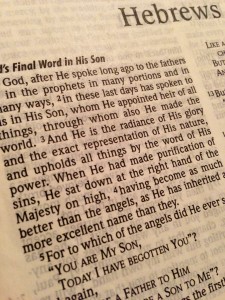 As the name suggests, prevenient grace is grace that ‘comes before’ something. It is normally defined as a work that God does for everybody. He gives all people enough grace to respond to Jesus. That is, it is enough grace to make it possible for people to choose Christ. Those who cooperate with and assent to this grace are ‘elect.’ Those who refuse to cooperate with this grace are lost.
As the name suggests, prevenient grace is grace that ‘comes before’ something. It is normally defined as a work that God does for everybody. He gives all people enough grace to respond to Jesus. That is, it is enough grace to make it possible for people to choose Christ. Those who cooperate with and assent to this grace are ‘elect.’ Those who refuse to cooperate with this grace are lost.
The strength of this view is that it recognizes that fallen man’s spiritual condition is severe enough that it requires God’s grace to save him. The weakness of the position may be seen in two ways. If this prevenient grace is merely external to man, then it fails in the same manner that the medicine and the life preserver analogies fail. What good is prevenient grace if offered outwardly to spiritually dead creatures?
On the other hand, if prevenient grace refers to something that God does within the heart of fallen man, then we must ask why it is not always effectual. Why is it that some fallen creatures choose to cooperate with prevenient grace and others choose not to? Doesn’t everyone get the same amount?
Think of it this way, in personal terms. If you are a Christian you are surely aware of other people who are not Christians. Why is it that you have chosen Christ and they have not? Why did you say yes to prevenient grace while they said no? Was it because you were more righteous than they were? If so, then indeed you have something in which to boast. Was that greater righteousness something you achieved on your own or was it the gift of God?
If it was something you achieved, then at the bottom line your salvation depends on your own righteousness. If the righteousness was a gift, then why didn’t God give the same gift to everybody?
Perhaps it wasn’t because you were more righteous. Perhaps it was because you are more intelligent. Why are you more intelligent? Because you study more (which really means you are more righteous)? Or are you more intelligent because God gave you a gift of intelligence he withheld from others?
To be sure, most Christians who hold to the prevenient grace view would shrink from such answers. They see the implied arrogance in them. Rather they are more likely to say, “No, I chose Christ because I recognized my desperate need for him.”
That certainly sounds more humble. But I must press the question. Why did you recognize your desperate need for Christ while your neighbor didn’t? Was it because you were more righteous than your neighbor, or more intelligent?
The $64 question for advocates of prevenient grace is why some people cooperate with it and others’ don’t. How we answer that will reveal how gracious we believe our salvation really is.
The $64,000 question is, “Does the Bible teach such a doctrine of prevenient grace? If so, where?”
We conclude that our salvation is of the Lord. He is the One who regenerates us. Those whom he regenerates come to Christ. Without regeneration no one will ever come to Christ. With regeneration no one will ever reject him. God’s saving grace effects what he intends to effect by it.
………. p. 213 Let me close the book by mentioning that soon after I awoke to the truth of predestination I began to see the beauty of it and taste its sweetness. I have grown to love this doctrine. It is most comforting. It underlines the extent to which God has gone in our behalf. It is a theology that begins and ends with grace. It begins and ends with doxology. We praise a God who lifted us from spiritual deadness and makes us walk in high places. We find a God who may be against us. It makes our souls rejoice to know that all things are working together for our good. We delight in our Savior who truly saves us and preserves us and intercedes for us. We marvel at his craftmanship and in what he has wrought. We skip and kick our heels when we discover his promise to finish in us what he has started in us. We ponder mysteries and bow before them, but not without doxology for the riches of grace he has revealed:
Oh, the depth of the riches both of the wisdom and knowledge of God! … For of Him and through Him and to Him are all things, to whom be glory forever. Amen. (Romans 11:33, 36)
“God Himself supplies the necessary condition to come to Jesus, that’s why it is sola gratia, by grace alone, that we are saved.” – R. C. Sproul



